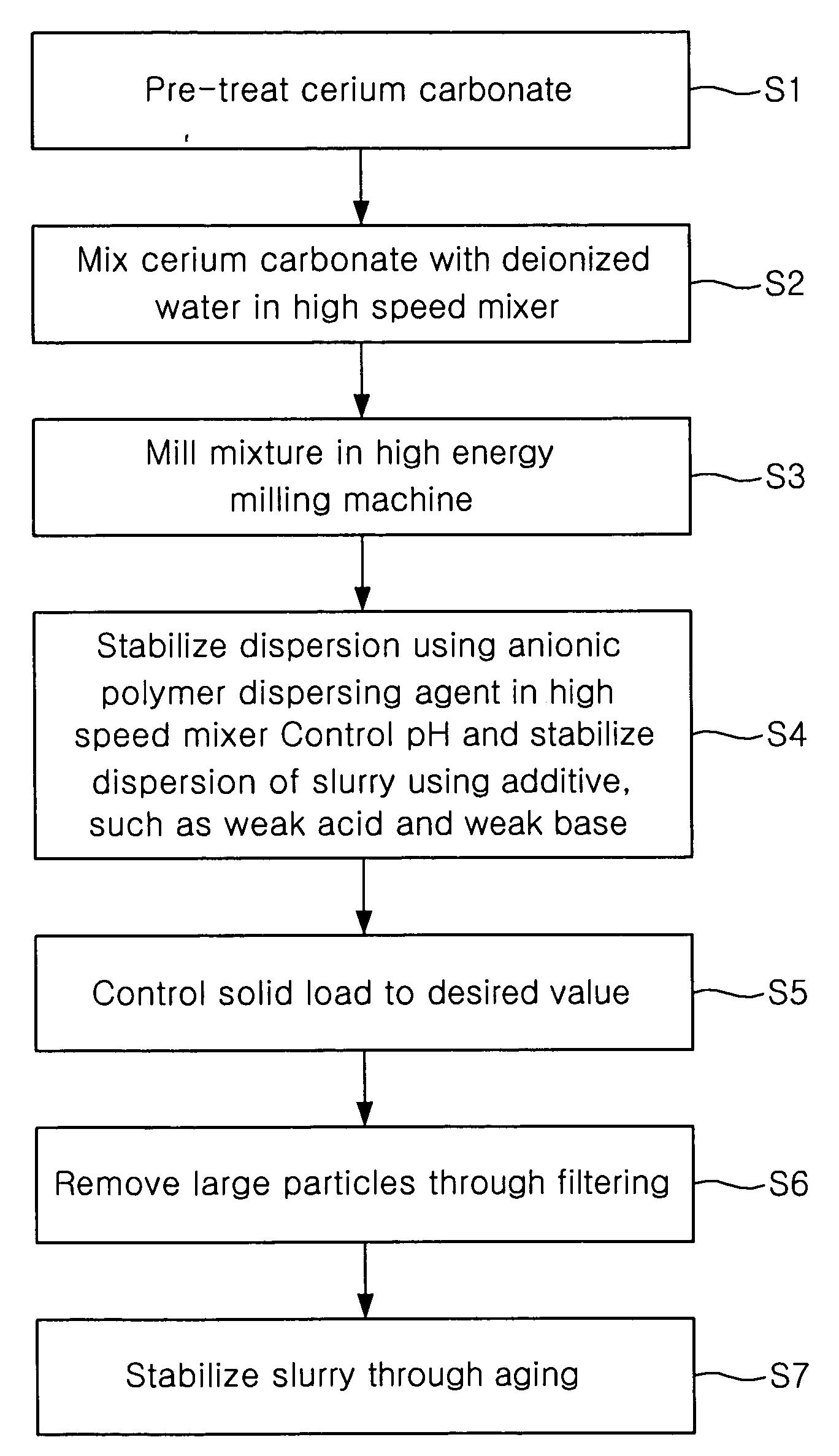Polishing slurry, method of producing same, and method of polishing substrate
a technology of polishing slurry and substrate, which is applied in the field of polishing slurry, can solve the problems of uneven surface flattening, excessive volume removal of oxide layer, and discoloration phenomenon, and achieve the effect of stabilizing dispersion
- Summary
- Abstract
- Description
- Claims
- Application Information
AI Technical Summary
Benefits of technology
Problems solved by technology
Method used
Image
Examples
examples 1 to 5
Dependence on Calcination Temperature (1) Preparation of ceria powders 1 to 5
[0102] 25 kg of highly pure cerium carbonate was charged in a container by about 800 g at every temperature, and calcined in a calcination furnace for 4 hours. With respect to the calcination temperature of examples 1 to 5, the temperature increase rate and the holding temperature were as follows.
TABLE 5TemperatureHoldingincrease rate(° / min)temperature(°)Ceria powder 13.9700Ceria powder 24.2750Ceria powder 34.4800Ceria powder 44.7850Ceria powder 55.0900
[0103] Spontaneous cooling was conducted in such a way that gas flowed at a rate of 20 m3 / hr to effectively remove CO2 generated as a byproduct. The calcined ceria powder was analyzed by X-ray diffraction, resulting in confirmation that highly pure cerium oxide was produced. Furthermore, the powder was analyzed using a TEM and an SEM (see FIGS. 3 to 5), it can be seen that the grain size and the primary particle size rapidly increased as the calcination te...
examples 6 to 8
Dependence on the Number of Milling Passes
[0108] (1) Preparation of ceria powders 6 to 8
[0109] 75 kg of highly pure cerium carbonate was charged in a container by about 800 g, and calcined in a calcination furnace at 750° for 4 hours. Spontaneous cooling was conducted in such a way that gas flowed at a rate of 20 m3 / hr to effectively remove CO2 generated as a byproduct. The calcined ceria powder was analyzed by X-ray diffraction, resulting in confirmation that highly pure cerium oxide was produced.
[0110] (2) Preparation of ceria slurries 6 to 8
[0111] In order to produce the ceria slurry 6, 10 kg of synthesized highly pure ceria powder and 90 kg of deionized water were mixed with each other for 1 hour or more in a high speed mixer so as to achieve sufficient wetting, and the mixture, that is, 10 wt % slurry was subjected to 4 passes of a milling process. Thereby, the particle size was controlled to a desired range and cohering particles in the slurry were dispersed. Subsequently,...
examples 9 to 11
Dependence on the Median Size of Polishing Particles
[0114] (1) Preparation of ceria powders 9 to 11
[0115] 75 kg of highly pure cerium carbonate was charged in a container by about 800 g, and calcined in a calcination furnace at 750° for 4 hours. Spontaneous cooling was conducted in such a way that gas flowed at a rate of 20 m3 / hr to effectively remove CO2 generated as a byproduct. The calcined ceria powder was analyzed by X-ray diffraction, resulting in confirmation that highly pure cerium oxide was produced.
[0116] (2) Preparation of Ceria Slurries 9 to 11
[0117] In order to produce the ceria slurry 9, 10 kg of highly pure ceria powder and 90 kg of deionized water were mixed with each other for 1 hour or more in a high speed mixer so as to achieve sufficient wetting, and the mixture, that is, 10 wt % slurry, was repeatedly subjected to a milling process until the median size of secondary particles was 205 nm, for example, 7 passes. Through the milling process, the particle size w...
PUM
| Property | Measurement | Unit |
|---|---|---|
| Angle | aaaaa | aaaaa |
| Size | aaaaa | aaaaa |
| Size | aaaaa | aaaaa |
Abstract
Description
Claims
Application Information
 Login to View More
Login to View More - R&D
- Intellectual Property
- Life Sciences
- Materials
- Tech Scout
- Unparalleled Data Quality
- Higher Quality Content
- 60% Fewer Hallucinations
Browse by: Latest US Patents, China's latest patents, Technical Efficacy Thesaurus, Application Domain, Technology Topic, Popular Technical Reports.
© 2025 PatSnap. All rights reserved.Legal|Privacy policy|Modern Slavery Act Transparency Statement|Sitemap|About US| Contact US: help@patsnap.com



